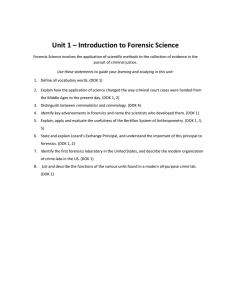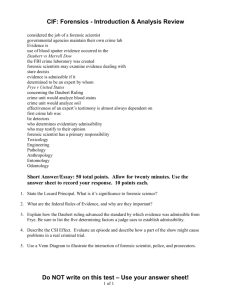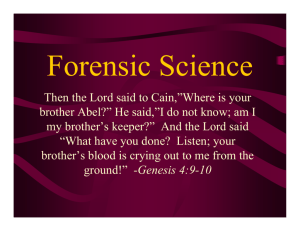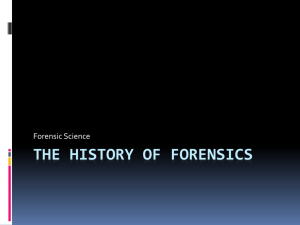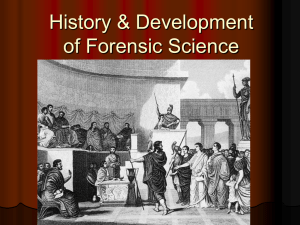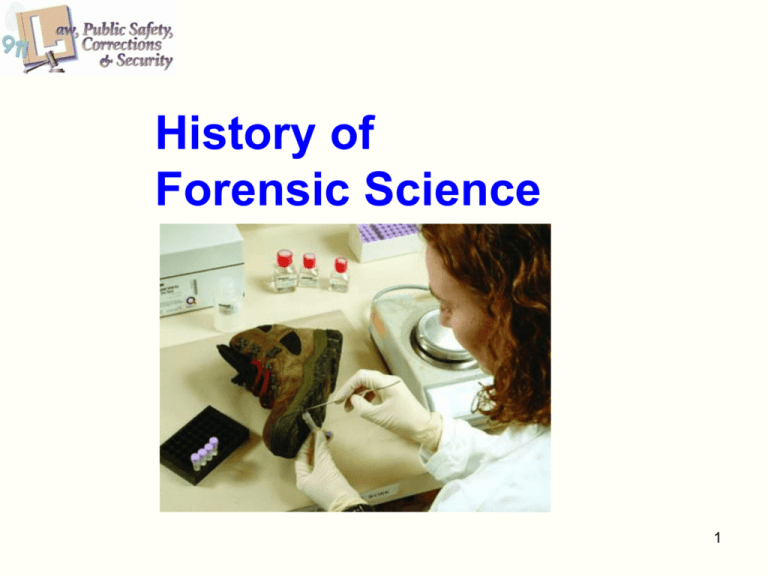
History of
Forensic Science
1
Objectives
1. Define all vocabulary words. (DOK 1)
2. Explain how the application of science changed the way criminal
court cases were handed from the Middle Ages to the present day.
(DOK 1, 2)
3. Distinguish between criminalistics and criminology. (DOK 4)
4. Identify key advancements in forensics and name the scientists
who developed them. (DOK 1)
5. Explain, apply and evaluate the usefulness of the Bertillon System
of Anthropometry. (DOK 1, 3, 5)
6. State and explain Locard’s Exchange Principal, and understand the
important of this principal to forensics. (DOK 1, 2)
7. Identify the first forensics laboratory in the United States, and
describe the modern organization of crime labs in the US. (DOK 1)
2
Before 17th century
Confrontation by the accuser
Confession under torture
GUILTY
Strength to resist the pain
INNOCENT
3
Forensic Science
the application of science to the court of law
Forensis” meaning forum
A public place where, in Roman times,
senators and others debated and
held judicial proceedings
Criminalistics
the application of scientific techniques
in collecting and analyzing physical
evidence
4
Criminalistics vs Criminology
Criminalistics
Criminology
the scientific
examination of
physical evidence for
legal purposes.
includes the
psychological angle,
studying the crime
scene for motive,
traits, and behavior
that will help to
interpret the evidence
Early Use of Forensics
3rd Century China:
• Coroner solved a case where a woman
was suspected of murdering her
husband and burned the body
• She claimed he died in an accidental fire
• Coroner tested whether or not a body
would have ashes in its mouth if it died
in a fire by using pigs
• The pig that was alive during the fire had
ashes in its mouth; the husband did not.
• When confronted with the coroner’s
evidence, the woman confessed.
Marcello Malpighi
• Professor of Anatomy at University of
Bologna in Italy
• Wrote some of the first recorded notes
about fingerprint characteristics in 1686
• But even he didn’t see their value as a
way to indentify people
Carl Wilhelm Scheele
• 1775
• Swedish Chemist
• Devised the test for
detecting the poison
arsenic in corpses
7
Valentin Ross
• German Chemist
• 1806
• Discovered a more precise
method for detecting small
amounts of Arsenic
Mathieu Orfilla
•
•
•
•
Spain
1814
“Father of Forensic Toxicology”
Published the first scientific treatise
on the detection of poisons
8
1828:
The invention of the
Polarized Light Microscope
1839:
First microscopic
detection of sperm
9
James Marsh
• Scottish Chemist
• 1839
• The first to testify in a
criminal trial on the
detection of Arsenic in
a victim’s body
• “expert witness” using
science in a legal
context
10
1863:
The first presumptive test for
blood
1850’s – 1860’s:
Development in photography and
Improved records in forensic science
11
Alphonse Bertillon
• French Anthropologist
• Introduced the Bertillon System
(aka Anthropometry) in 1879
• Used various measurements of
the body to identify people by
their physical appearance
• Eventually replaced by
fingerprinting
• Also considered “father of the
mugshot.”
12
Bertillon’s
Anthropometry
What does this picture make you think of?
“Sherlock Holmes”
• Fictional character in books by Sir Arthur
Conan Doyle
• First book: A Study in Scarlet, 1887
• Popularized using scientific method in
solving crimes
• Described elements of newly developing
techniques in serology,
fingerprinting, firearm
examination, and document
examination
Francis Henry Galton
• Wrote the first definitive study of
fingerprints and developed a
classification system
• 1892: published Finger Prints book
Hans Gross
• Austrian prosecutor and judge
• 1893
• Published Criminal Investigation
• Discussed the benefits of science in
criminal investigations
16
Karl Landsteiner
• 1901
• Discovered ABO Blood typing
Albert Osborn
• 1910
• Published Questioned Documents
17
Edmond Locard
• 1877-1966
• French
doctor/criminologist
• Developed Locard’s
Exchange Principle
• Opened the very first
crime laboratory in
France
18
Locard’s Exchange Principle
• “…with contact between two items, there
will be an exchange.”
Walter McCrone
• 1916-2002
• American chemist
• Microscopy expert
• Examined The Shroud of
Turin and the Vinland
map
20
Sir Alec Jeffreys
• 1984
• Developed first DNA Profiling test
History of Crime Labs in the United States
1923:
Los Angeles PD Crime Lab: *the 1st crime lab in US*
1930’s:
University of CA at Berkeley Dept. of
Criminalistics headed by Paul Kirk
1932:
FBI Director J. Edgar Hoover opens the FBI Laboratory
1981:
FBI opens Forensic Science Research and Training Center
22
Federal Crime Laboratories
• FBI Laboratory (Quantico, VA)
• Drug Enforcement Administration (DEA)
Laboratories
• Bureau of Alcohol, Tobacco, Firearms and
Explosives (ATF) Laboratories
• U.S. Army Crime Investigation Laboratory
(Fort Gillem, GA)
• U.S. Postal Inspection Service Laboratories
23
Crime Labs Abroad
• The British Home Office
– Metropolitan Police Laboratory (London),
a.k.a. “Scotland Yard”
– 5 other regional labs
• Canada
– Royal Canadian Mounted Police (RCMP)
Laboratories
– Centre of Forensic Sciences (Toronto)
– The Institute of Legal Medicine and Police
Science (Montreal)
24
Resources
• Saferstein, Richard. Forensic Science: An Introduction.
New Jersey: Pearson Prentice Hall, 2008.
• Bertino, Anthony J. Forensic Science: Fundamentals
and Investigations. Mason, OH: South-Western
Cengage Learning, 2009.
• http://www.officer.com/publication/article.jsp?pubId=1&id=25192
25
Image Sources
1)
2)
3)
4)
5)
6)
7)
8)
9)
10)
11)
12)
13)
14)
http://theopinionation.net/blog/wp-content/uploads/2009/06/10-medieval-torturedevices8.jpg
http://www.nndb.com/people/492/000095207/carl-wilhlem-scheele-1-sized.jpg
http://www.all-about-forensic-science.com/alphonse-bertillon.html
http://www.fact-archive.com/encyclopedia/upload/thumb/a/a9/250pxMathieu_Joseph_Bonaventure_Orfila.jpg
http://img.directindustry.com/images_di/photo-g/polarization-microscope-304081.jpg
http://www.historyforkids.org/scienceforkids/biology/cells/pictures/sperm.jpg
http://en.wikipedia.org/wiki/File:Marsh_James.jpg
http://blog.bloodonthemotorway.com/wp-content/uploads/2009/10/Blood_Spatter.jpg
http://en.wikipedia.org/wiki/File:Marsh_James.jpg
http://www.gusto-graeser.info/Monteverita/Personen/GrossOtto/Hans_Gross.jpg
http://media-2.web.britannica.com/eb-media/75/68975-050-00CBB315.jpg
http://www.osbornandson.com/backgnd.html
http://www.bestforensicscienceschools.com/2009/top-10-most-famous-forensicexperts-in-history/
http://www.mcri.org/home/section/2-8/dr.-walter-c.-mccrone
26


